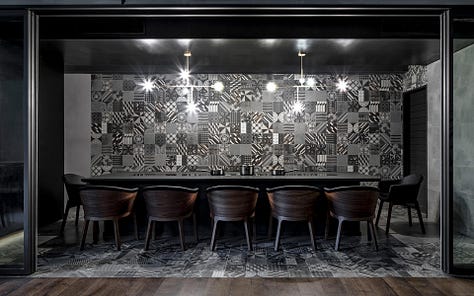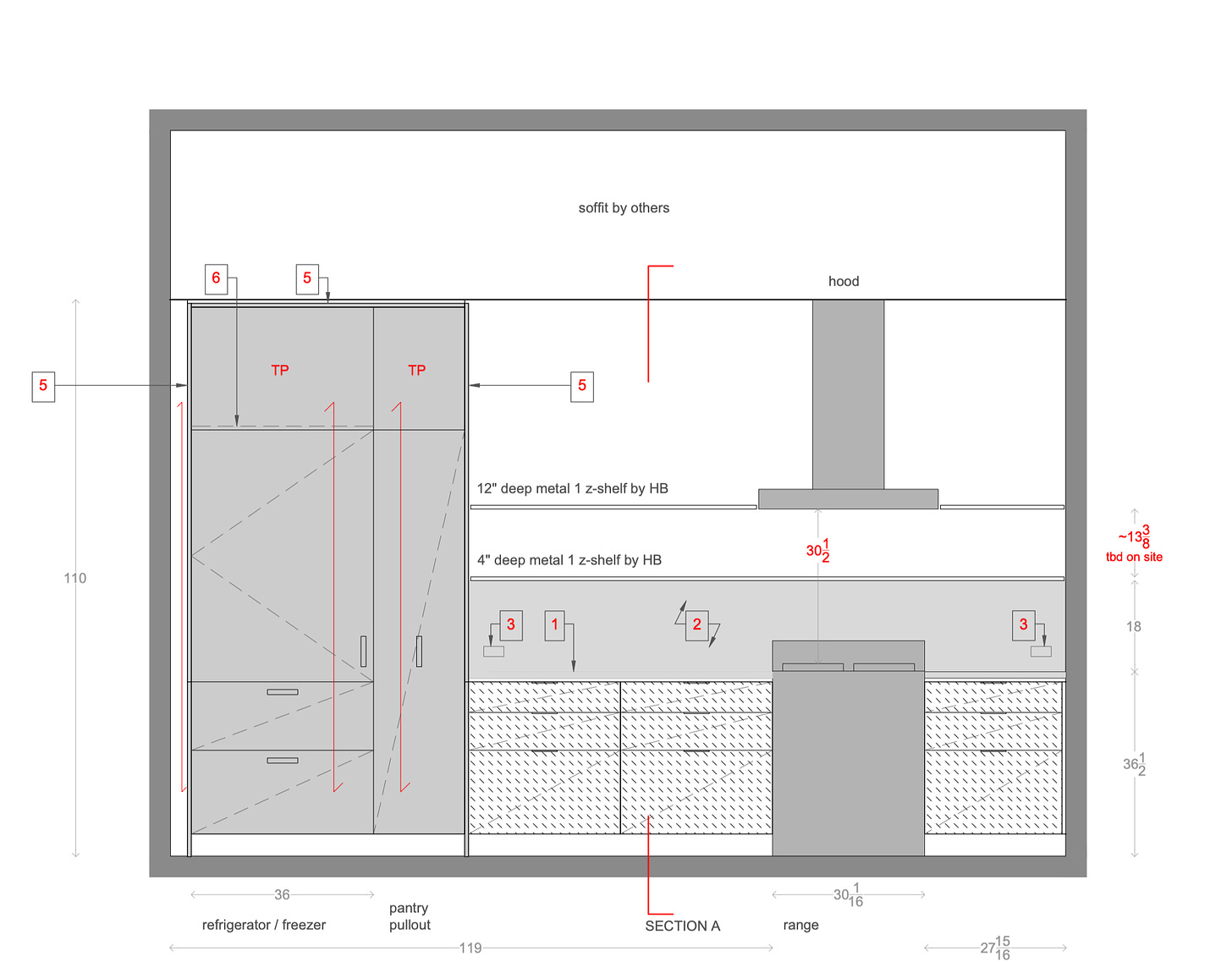Thank you so much for subscribing.
I purchased a beautiful muted tile for my kitchen backsplash, but things took an unexpected turn. Perhaps I need to start saying “expected turn” as so many things have gone wrong.
The tile I chose is a traditional-looking modern tile called Azulej and produced by the Italian company Mutina. It was designed by Patricia Urquiola, a fantastic contemporary architect and designer. Below are photos of a hotel she designed. In addition to her architectural work, she has also created a range of home products, including sofas, rugs, kitchenware, tiles, and more.




The tile caught my eye for several reasons
The Azulej collection draws inspiration from ancient majolica tiles while incorporating a modern design language. Featuring a variety of intricate patterns and textured surfaces, the tile offer a wide range of arrangements. Even though it looks like cement tile in both material and patterning, it is actually made of rectified porcelain that has been digitally printed by overlaying textural layers.
Azulez avoids the problems associated with traditional handmade tile
While traditional cement tiles are beautiful, their installation can be challenging. Handmade tiles have inherent irregularities, and need to be installed carefully to create an even surface. They are also porous, and need to be sealed properly. Otherwise, they will the absorb impurities and moisture which can create problems.
Advances in tile production means that there are now modern porcelain alternatives (like Azulej) that look like handmade tiles but without the drawbacks. Porcelain tiles can be laid evenly and quickly, without the need for manual compensations required by handmade tiles. Porcelain is durable and relatively resistance to scratches, stains, and moisture. The tiles will not trap water like cement and clay tiles so they are less likely to discolor or smell musty.
If you don’t want big grout lines then choose rectified tile:
‘Rectified’ refers to the precise cutting of tile edges to exact measurements, resulting in straight edges and precise dimensions. This process enables tiles to be laid with minimal grout joints, achieving a seamless appearance. While some contractors may insist on wide grout lines, which many homeowners dislike, rectified tiles eliminate the need for such wide joints. It's important to check the specifications yourself, as most contractors may not do so.
The Azulej collection has 27 patterns in three shades (nero, grigio, and blanco). Due to the complementary shades and patterns, it offers considerable compositional freedom, eliminating the need to match adjacent tiles perfectly. It can be used on floors, walls, alcoves, and both indoor and outdoor spaces it does a superb job of maintaining aesthetic appeal across varied applications.









The irony of the name is not lost on me
I opted for the tile pattern called Azulej 'Trama,' a choice that seems oddly fitting in hindsight as it seemed to foreshadow the 'trauma and drama’ I experienced during and after the kitchen installation—and for the whole project, really.
Trama had a modern aesthetic that harmonized well with the grey and walnut cabinetry I had chosen, and my white floor tiles.



Like many of my other finishes, the tile had been sitting around the house for about five years since the contractor didn't work on the kitchen until then. Finally, when they began the kitchen renovation, the crew started installing the tile. On the day of the installation, I received a call from the contractor asking me to come down. I went downstairs and found the contractor standing there with his team, along with a small stack of broken tiles on the kitchen island. With a gleeful expression, he asked, "What's wrong with your tile?" I admitted I didn't know. He then exclaimed, "Every single one cracked when we tried to drill through it. This has never happened before!
You may be wondering why we had to drill through the tile. The plans called for steel shelves to be installed, but not through the tile. Unfortunately, I wasn't paying close attention at the time, as I assumed they were following the plans. By this point, the tile was already extending from the counter all the way up to the kitchen hood.
A suspicious package
Despite the tile pieces not being large—about 8 inches square (20x20 cm)—they were dense and heavy, making them difficult to drill through. Having experienced drilling through hard materials before, I knew the importance of using an appropriate drill bit. I assumed the contractors were using the correct drill bit, so I was puzzled by the situation.
When in doubt, I like to contact the manufacturer or retailer. I have a good rapport with the salesperson at Stone Source. I gave him a call and explained the issue. He responded, 'That's very strange. We sell a lot of this tile, and we've never had that problem before. You're the first person to have complained about it.' After some discussion, he paused and suggested, 'Ask your contractor if he's using a diamond drill bit.'
I went back downstairs and asked the contractor if he was using a diamond drill bit. He responded with a loud exclamation, 'Well, that's such an obvious thing for you to say, ha haha,' which seemed to indicate that he had indeed been using one. At that point, I may have suggested using masking tape to help with the drilling, and then I left. The next day, when I returned to check on the progress, I was in disbelief. On the kitchen counter, right next to the tile backsplash, sat a brand new diamond drill bit still sealed in its package.
%#$#I#* @#$#ˆˆ%
The tile mishap was just one in a series of errors
The backsplash, initially intended to be 10 feet by 18 inches, ended up being nearly 30 inches high. The space around the hood wasn’t according to the plans so the shelves didn’t fit which left an unsightly gap where light streams through.
The tall cabinetry had holes in it probably from improper drilling. The top of the cabinet did not line up with the ceiling above. instead it slanted down from left to right so it wasn’t even parallel with the soffit.
They didn’t frame the opening for the cabinetry correctly. As a result, one of the cabinets didn’t fit and I had to buy a whole new one which cost $$$.
And last but not least, the sliding doors that led to the outside sank in the middle and whole floor had been done incorrectly.
And lastly an update on the lawsuit that won’t die
For those who may be unfamiliar with RenoQueen’s background, I've had to take legal action against the contractor due to severe and costly damages that forced me to stop construction entirely. A case that was supposed to be a few weeks has now dragged on for years and has now been topped up with more paperwork and as of this past week, another extension.
I've spent the last month researching and writing legal briefs. Wondering if I have a construction lawyer? I do. However, after witnessing the outcomes of some briefs that rely on detailed construction and legal research, I knew I had no option but to assist. With so much at stake, I can't afford to take chances. Even if I lose or gain nothing, at least I'll know that I gave it my best.
Thank you for reading. Feel free to heart or post comments or questions if you feel like it.
Related content:
Drywall Debacles
Thank you for reading and your continued support. I wrote this post after several drywall mishaps and witnessing sloppy methods from contractors. Drywall was first made by the U.S. Gypsum Company (USG) in 1916 and introduced as an alternative for lath and plaster. Initially it was called "Sackett Board," after the Sackett Plaster Company which USG acqu…
The Day The Tile Fell Off The Wall
I hope everyone is having a wonderful January and thanks for reading. If you have a moment, please let me know what you think in the comments below. A few years back, as I was in the basement, I heard multiple sharp, thudding noises coming from the center of the floor. As I walked toward the sound, I was startled t…
Queen’s Repository
Resources
Mutina tiles are available at Stone Source in the United States and can be found at Tile Expert in the UK.
Mutina.it












What gorgeous tile!! I'm glad to learn about it. I canNOT believe the incompetence of the contractor. Even I know about diamond drill bits. That bluster is super annoying. I hope your legal case resolves soon.
Oh my goodness, infuriating!!! Even I - who knows practically nothing about renovations- know to use a diamond drill bit when drilling thru ANY tile!!! As for following the plans, I guess the assumption needs to be that they dont know how to read. Seriously.
Errrr and Ugh!!😩🤦🏻♀️😤